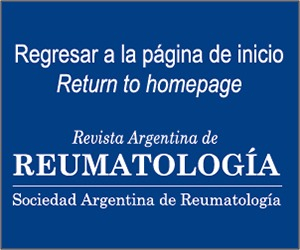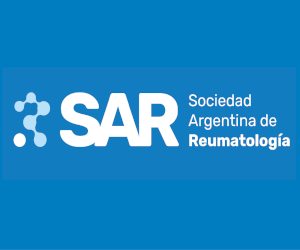Kidney involvement in IgG4-related disease
Abstract
Introduction: IgG4-related Kidney desease (IgG4-RKD) has a prevalence of 8 to 24%, more frequent in males (73-87%), with a mean age of 65 years. Objective: to determinate the kidney involvement finding and their frequency in patients with IgG4-related disease (IgG4-RD). To describe and compare demographic, clinical characteristics, laboratory data and treatment among patients with IgG4-RD who have kidney involvement versus patients without kidney involvement. Materials and methods: we conducted a retrospective observational study of patients with IgG4-related kidney (IgG4-RKD) in a IgG4-RD cohort. Data were collected through review of medical records. We describe clinical parameters at baseline, histological and radiological findings and treatment. Results: of 44 patients with IgG4-RD, 6 (13.6%) had IgG4-RKD. Patients were aged 50,8±17,1 years, and 4 were female. All of them had involvement the other organs systems. The most common radiological finding was low-density lesions on enhanced CT. Three patients had a renal biopsy, the main histopathological diagnosis being IgG4 tubulointerstitial nephritis. All patients received glucocorticoids and immunosupresor as initial management. Patients with kidney disease, as opposed to patients without kidney involvement had a higher number of involved organs, and IgG2, IgG3 serum levels and lower C3 level. Conclusions: in general, the characteristics of patients with ER-IgG4 and kidney involvement were similar to published works.References
I. Stone JH, Brito-Zerón P, Bosch X and Ramos-Casals M. Diagnostic approach to the complexity of IgG4-related disease. Mayo Clin Proc 2015;90(7):927-939.
II. Nares EM, Hernández-Molina G, et al. IgG4-related kidney disease: experience from a Mexican cohort. Clinical Rheumatology 2019.
III. Olczyk E, Krajewska M, Klinger M. Manifestations of IgG4-related kidney disease: diagnosis and treatment. Neprol Dial Pol 2017;21:128-131.
IV. Takahashi N, Kawashima A, Fletcher JG, Chari S. Renal involvement in patients with autoimmune pancreatitis: CT and MR imaging findings. Radiology 2007;242(3):791-801.
V. Umehara H, Okazaki K, Kawa S, et al.; Research Program for Intractable Disease by the Ministry of Health, Labor and Welfare (MHLW) Japan. The 2020 revised comprehensive diagnostic (RCD) criteria for IgG4-RD. Mod Rheumatol 2021;31(3):529-533.
VI. Umehara H, Okazaki K, Masaki Y, et al. Comprehensive diagnostic criteria for IgG4-related disease (IgG4-RD), 2011. Mod Rheumatol Jpn Rheum Assoc 2012;22:21-30.
VII. Wallace ZS, Naden RP, Chari S, Choi H, Della-Torre E, Dicaire JF, et al. The 2019 American College of Rheumatology/European League Against Rheumatism Classification Criteria for IgG4-Related Disease. Ann Rheum Dis 2020;79(1):77-87.
VIII. Culver EL, et al. Elevated serum IgG4 levels in diagnosis, treatment response, organ involvement, and relapse in a prospective IgG4-related disease UK cohort. Am J Gastroenterol 2016;111(5):733-43.
IX. Chan ASY, Mudhar H, et al. Serum IgG2 and tissue IgG2 plasma cell elevation in orbital IgG4-related disease (IgG4-RD): potential use in IgG4-RD assessment. Br J Ophtahlmol 2017;101(11):1576-1582.
X. Miller A, Green M, Robinson D. Simple rule for calculating normal erythrocyte sedimentation rate. Br Med J (Clin Res Ed) 1983;286(6361):266.
XI. Quattrocchio G, Roccatello D. IgG4-related nephropathy. Journal of Nephrology 2016;29(4):487-493.
XII. Evans R, Cargill T, Goodchild G, Oliveira B, et al. Clinical manifestations and long-term outcomes of IgG4-related kidney and retroperitoneal involvement in a United Kingdom IgG4-related disease cohort. Kidney International Reports (2019);4:48-58.
XIII. Wang L, Zhang P, Zhang X, et al. Sex disparities in clinical characteristics and prognosis of immunoglobulin G4 related disease: a prospective study of 403 patients. Rheumatology 2019;58: 820-830.
XIV. Saeki T, Nishi S, Imai N, et al. Clinicopathological characteristics of patients with IgG4-related tubulointerstitial nephritis. Kidney International (2010);78:1016-1023.
XV. Kawano M, Saeki T, Nakashima H, et al. Proposal for diagnostic criteria for IgG4-related kidney disease. Clin Exp Nephrol 2011;15:615-626.
XVI. Raissian Y, Nasr S, Larsen CP, et al. Diagnosis of IgG4-related tubulointerstitial nephritis. J Am Soc Nephrol 2011;22:1343-1352.
XVII. Inoue D, Yoshida K, Yoneda N, et al. IgG4-related disease: dataset of 235 consecutive patients. Medicine (Baltimore) 2015;94:680.
XVIII. Shoji S, Nakano M, Usui Y. IgG4-related inflammatory pseudotumor of the kidney. International Journal of Urology 2010;17:389-390.
XIX. Alexander M, Larsen CP, Gibson I, et al. Membranous glomerulonephritis is a manifestation of IgG4-related disease. Kidney International 2013;83:455-462.
XX. Khosroshahi A, Ayalon R, Beck LH, Salant DJ, et al. IgG4-related disease is not associated with antibody to the phospholipase A2 receptor. Int J Rheumatol 2012; 139409.
XXI. Deshpande V, Zen Y, Chan J, et al. Consensus statement on the pathology of IgG4-related disease. Modern Pathology 2012; 25:1181-1192.
XXII. Yamaguchi Y, Kanetsuna Y, Honda K, et al. Characteristic tubulointerstitial nephritis in IgG4-related disease. Pathol 2012;43:536-549.
Copyright (c) 2023 on behalf of the authors. Reproduction rights: Argentine Society of Rheumatology

This work is licensed under a Creative Commons Attribution-NonCommercial-NoDerivatives 4.0 International License.










